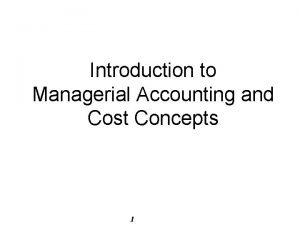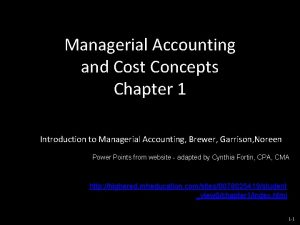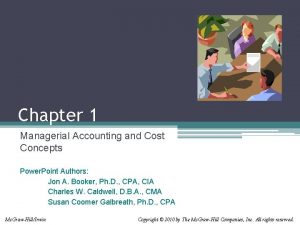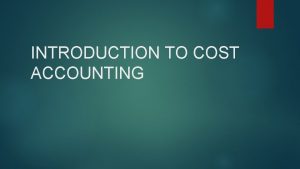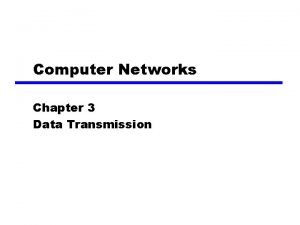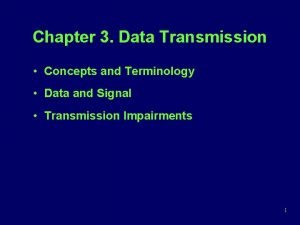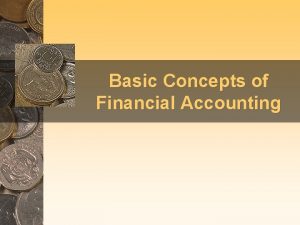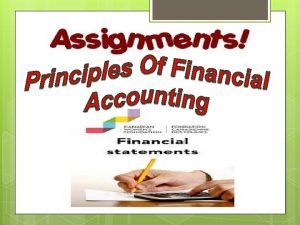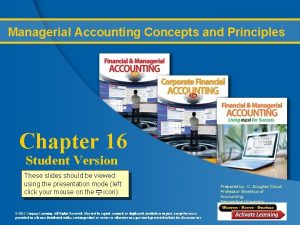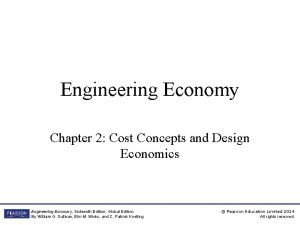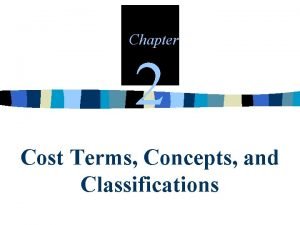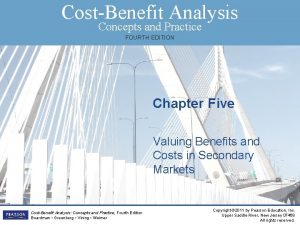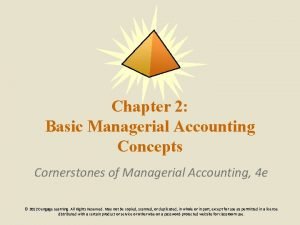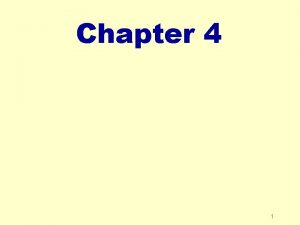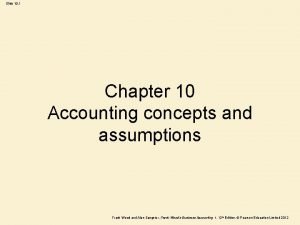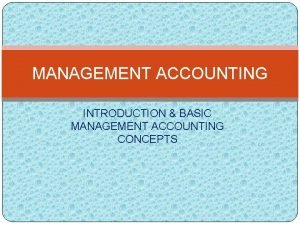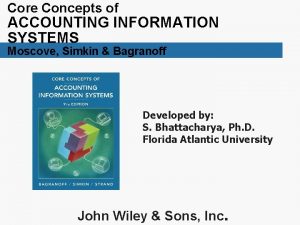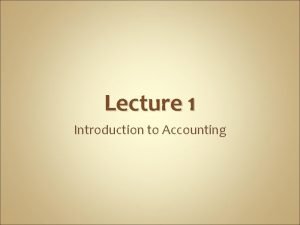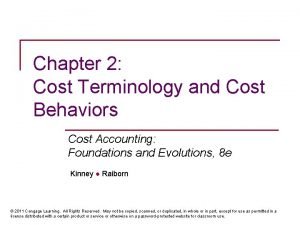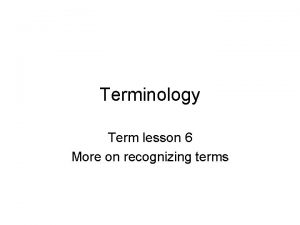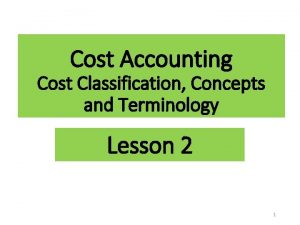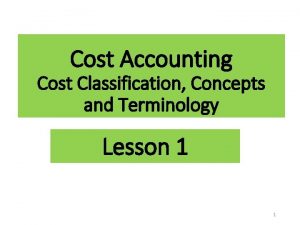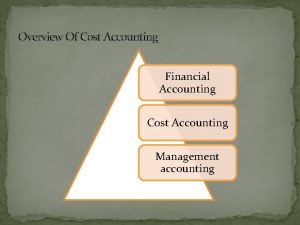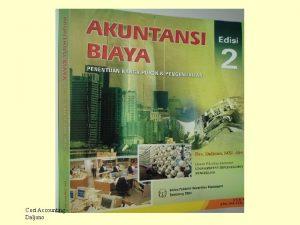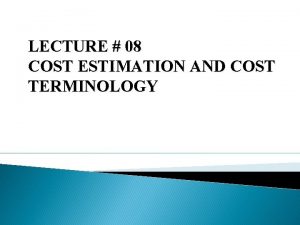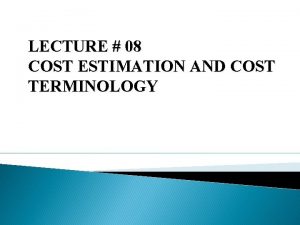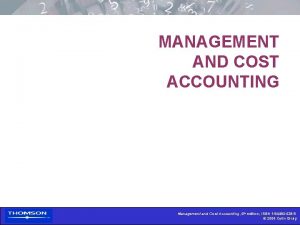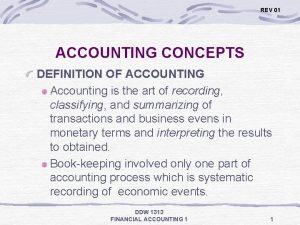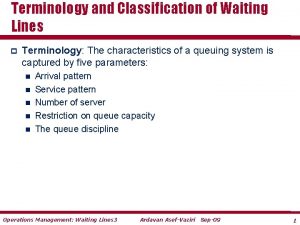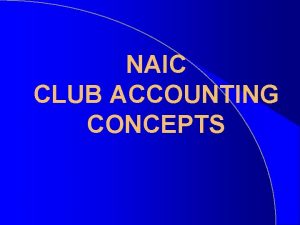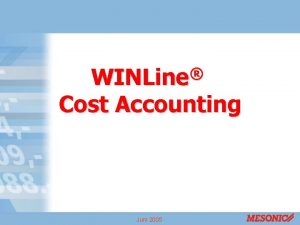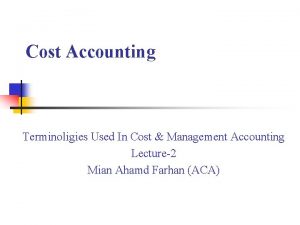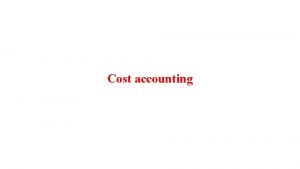Cost Accounting Cost Classification Concepts and Terminology Lesson



























- Slides: 27

Cost Accounting Cost Classification, Concepts and Terminology Lesson 3 1

Understand the cost classification used for cost decision-making 2

Question ABC Company manufactures a single product. A partially completed schedule of the company’s production costs over the range of 30, 000 to 50, 000 units produced is given below: Units Produced Direct materials Electricity Factory rent 30, 000 $5, 000 $60, 000 40, 000 $5, 000 $60, 000 50, 000 $6, 200 $60, 000 Can you identify the difference among the above cost items? 3

What is Cost Behaviour? Cost behaviour describes how a cost changes as the level of activity (e. g. number of outputs) changes. For example: The total cost of direct materials increases when the number of units produced increases. 4

Fixed Cost u Fixed cost is a cost that its total remains constant within a relevant range no matter whether the level of output increases or decreases, for example, factory rent. u Given the total of fixed costs remains constant, the fixed cost per unit decreases as the activity level increases. 5

Step Cost u Step cost describes the situation that the total fixed cost of a product would remain constant for a certain range of output level, but would then jump to a higher level of total fixed cost beyond that range of output level. u For example: The salary of supervisors which will increase after certain batches of products are checked. 6

Illustration : Fixed Cost / Step Cost Number of units produced Supervisors’ salaries 1 to 30, 000 $50, 000 30, 001 to 60, 000 $100, 000 60, 001 to 90, 000 $150, 000 90, 001 to 120, 000 $200, 000 Note: The total supervisor’s salaries remain unchanged within the range of 1 to 30, 000 units. Within this range, the amount of supervisors’ salaries paid is the same regardless of the number of units produced. So it is a fixed cost. The total amount jumps to $100, 000 at 30, 001 units and remains the same for a similar range of output level. Within the range of 1 to 120, 000 units, the cost of supervisors’ salaries is a step cost. 7

Variable Cost u Variable cost is a cost that its total varies in direct proportion to changes in output within the relevant range, for example, direct materials. u Variable cost per unit remains the same regardless of changes in the activity level. 8

Illustration : Variable Cost Number of units produced 20, 000 30, 000 40, 000 50, 000 Total cost of raw materials $100, 000 $150, 000 $200, 000 $250, 000 Unit cost $5* $5 $5 $5 Note: The total cost of raw materials increases in direct proportion to the number of units produced. As production doubles from 20, 000 to 40, 000 units, the total cost of raw materials doubles from $100, 000 to $200, 000. On the other hand, the unit cost remains constant. 9

Mixed Cost / Semi-variable Cost u Mixed cost / Semi-variable cost is a cost that possesses characteristics of both fixed and variable costs. u For example, telephone bill charges (basic monthly charges plus long distance charges). 10

Illustration : Mixed Cost / Semi-variable Cost Suppose a company has 5 sales assistants, each earning a salary of $10, 000 each month plus a commission of $5 per unit sold. The following table shows the selling expenses at different levels of sales activity. Number of Fixed selling units sold expenses Variable selling expenses Total selling expenses Selling expenses per unit 20, 000 $50, 000 $100, 000 $150, 000 $7. 5 30, 000 $50, 000 $150, 000 $200, 000 $6. 67 40, 000 $50, 000 $200, 000 $250, 000 $6. 25 50, 000 $250, 000 $300, 000 $6 11

Classwork Classify each of the following as fixed, variable, mixed or step cost: 1. A warranty agreement in which the company pays $800 per month and $100 per hour of service time. 2. Fuel cost of the company’s motor van. 3. The cost of beer for a restaurant. 4. The cost of computer printers in the company’s office. 5. The salary of a receptionist in an audit firm. 12

Classwork 6. Electricity cost which includes a monthly bill charge amounted to $250 and an additional amount depending on the number of kilowatt -hours used. 7. The cost of hiring 10 new employees because the factory requires to add a new shift to increase its capacity. 13

Classwork - Solution Classify each of the following as fixed, variable, mixed or step cost: 1. 2. 3. 4. 5. 6. 7. Mixed cost Variable cost Fixed cost Mixed cost Step cost 14

How to Separate a Mixed Cost The high-low method is a common tool employed to determine what portion of a cost is fixed and what portion of a cost is variable. Small-business owners can use this information to create budgets and to help understand how changes in volume affect the company's costs in total and on a per-unit basis. 15

Four Steps in Using High-low Method We can use high-low method to calculate the total fixed cost and the variable cost rate, and construct a cost formula for a mixed cost. 1. Find the highest point and the lowest point from a given data set. 2. Use the highest point and the lowest point to calculate the variable cost rate. 3. Calculate the total fixed cost using the variable cost rate at either the highest point or the lowest point. 4. Construct the cost formula. 16

Illustration : High-low Method An accountant wants to calculate the fixed and variable costs associate with the electricity used in the factory. Data for the past five months was collected as follows: Month Electricity cost Machine hours (MH) Jan $3, 250 450 Feb $3, 500 Mar $4, 100 600 Apr $3, 350 470 May $2, 600 350 Jun $4, 250 595 17

Illustration: High-low Method We can use high-low method to calculate the total fixed cost and the variable cost per machine hour, and construct the total electricity cost formula. 1. Find the highest and the lowest points The highest point is in March: 600 machine hours The lowest point is in May: 350 machine hours 2. Calculate the variable cost per machine hour Variable cost per MH = ($4, 100 - $2, 600) / (600 - 350) = $6 per MH 18

Illustration: High-low Method 3. Calculate the total fixed cost We can either use the highest or the lowest point. Let’s use the highest point with the cost of $4, 100 and the machine hours of 600. Total fixed cost = $4, 100 – ($6 x 600) = $500 4. Construct the cost formula Total electricity cost = $500 + ($6 x MH) 19

Cost Classifications Used for Cost Decision-making The knowledge of how costs and revenues vary with different levels of activity is useful for cost decisionmaking. Managers are required to understand different cost behaviours in order to decide what products to sell, whether to make or buy component parts, what prices to charge, whether to accept special orders at special prices, etc. 20

Illustration: Facilitating Cost Decision-making ABC Café had the following figures related to sales and expenses for the year 2018: $’ 000 Sales Less: 500 Food and packaging 120 Wages and salaries 80 Rent 50 General selling and administrative expenses 70 320 Net Income 180 The Café served 5, 000 meals in 2018. The variable costs consisted of food and packaging, wages and salaries, and 40% of the general selling and administrative expenses. 21

Illustration: Facilitating Cost Decision-making Required: (a) Determine the variable cost per meal. (b) Determine the total fixed cost. (c) Please advise whether the owner should spend $10, 000 on advertisement in order to boost the sales to 5, 500 meals in 2019. 22

Illustration: Solution (a) Variable cost per meal = $(120, 000 + 80, 000 + 70, 000 x 40%) ÷ 5, 000 = $45. 6 (b) Total fixed cost = $(50, 000 + 70, 000 x 60%) = $92, 000 (c) Additional income if the Café served 5, 500 meals = $(100* – 45. 6**) x (5, 500 – 5, 000) – $10, 000*** = $17, 200 Therefore, the owner should spend $10, 000 on advertisement in order to obtain additional income of $17, 200. 23

Summary of Cost Classifications Purpose Cost Classifications Preparing financial statements 1. Direct costs and Indirect costs 2. Prime cost and Overheads Facilitating cost decisionmaking 1. 2. 3. 4. Fixed cost Step cost Variable cost Mixed cost 24

Key Points Covered 1. The meaning of cost behaviour. 2. The meanings of fixed cost, step cost, variable cost and mixed cost. 3. The high-low method used to analyse a mixed cost. 25

Homework: Q 4 26

END 27
 Managerial accounting cost concepts
Managerial accounting cost concepts Accounting principles and concepts
Accounting principles and concepts Chapter 1 managerial accounting and cost concepts
Chapter 1 managerial accounting and cost concepts Introduction of cost
Introduction of cost Terminology and concepts
Terminology and concepts Transmission terminology
Transmission terminology Data transmission concepts
Data transmission concepts Basic concepts of financial accounting
Basic concepts of financial accounting Accounting convention
Accounting convention Analyzing transactions
Analyzing transactions Accounting principles
Accounting principles Accounting principles and concepts
Accounting principles and concepts Cost concepts and design economics
Cost concepts and design economics Cost classifications
Cost classifications Cost-benefit analysis concepts and practice
Cost-benefit analysis concepts and practice Conversion cost formula
Conversion cost formula Chapter 4 accrual accounting concepts
Chapter 4 accrual accounting concepts 10 accounting concepts
10 accounting concepts Management accounting concepts
Management accounting concepts Core concepts of accounting information systems
Core concepts of accounting information systems Basic management accounting concepts
Basic management accounting concepts Accounting for partnership basic concepts
Accounting for partnership basic concepts Basic of accounting
Basic of accounting What is accountancy
What is accountancy Accrual accounting principles
Accrual accounting principles Cost terminology
Cost terminology Financial accounting chapter 1
Financial accounting chapter 1 Synonymy
Synonymy
